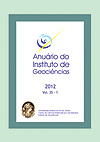The "Megadesastre" in the Mountain Region of Rio de Janeiro State: causes, mechanisms of mass movements and spatial allocation of investments for reconstruction post disaster
DOI:
https://doi.org/10.11137/2012_2_43_54Abstract
Every year, in Rio de Janeiro State, dozens of people die and thousands are affected by natural disasters related to extreme weather events, especially floods and landslides. In last years (2010 and 2011) more than thousand people died in disasters in Angra dos Reis, in the Metropolitan Region of Rio de Janeiro City and in the mountainous region of Rio de Janeiro State. The Megadesastre event occured in the mountainous region of Rio de Janeiro between days 11st and 12nd of January 2011, affecting seven cities in this region, especially Nova Friburgo, Teresópolis and Petrópolis, killing 947 people. It is considered one of the biggest events of mass movements widespread in Brazil. The event was triggered by extreme weather conditions of accumulated rainfall in order of 241.8 mm in 24 hours, with a peak of 61.8 mm in one hour, which helped make up the accumulated rainfall between days 1st and 12nd January of 573, 6 mm. The main type of mass movements observed in the area was debrisflows, mudflow, slips type "Parroca", "Rasteira", "Vale Suspenso" and "Catarina". For the spatial analysis of impacts in the region, we used the boundaries of the basins of 6th order, which divided the region into four basins: Piabanha River, Preto River, Rio Grande River and Macaé River. According to data from State Government, was invested in the recovery R$ 188,451,196.08 in 79 works in six municipalities. The city that received the highest number of interventions was Petrópolis (29) while Nova Friburgo was the municipality that received funds (R$ 91 million). In terms of basins, the Rio Preto River basin was the one that received the highest number of interventions (31) and that more resources were given to the Rio Grande basin (R$ 101 million). In relation inhabitant / resources invested, the basin of the Rio Grande River with the highest ratio (R$ 504.81 per capita) and similarly showed the most relative investment per km ² (R$ 101.5 / km ²).Downloads
Download data is not yet available.
Downloads
Published
2012-12-01
How to Cite
Dourado, F., Arraes, T. C. and Silva, M. F. e (2012) “The ‘Megadesastre’ in the Mountain Region of Rio de Janeiro State: causes, mechanisms of mass movements and spatial allocation of investments for reconstruction post disaster”, Anuário do Instituto de Geociências. Rio de Janeiro, BR, 35(2), pp. 43–54. doi: 10.11137/2012_2_43_54.
Issue
Section
não definida
License
This journal is licensed under a Creative Commons — Attribution 4.0 International — CC BY 4.0, which permits use, distribution and reproduction in any medium, provided the original work is properly cited.















